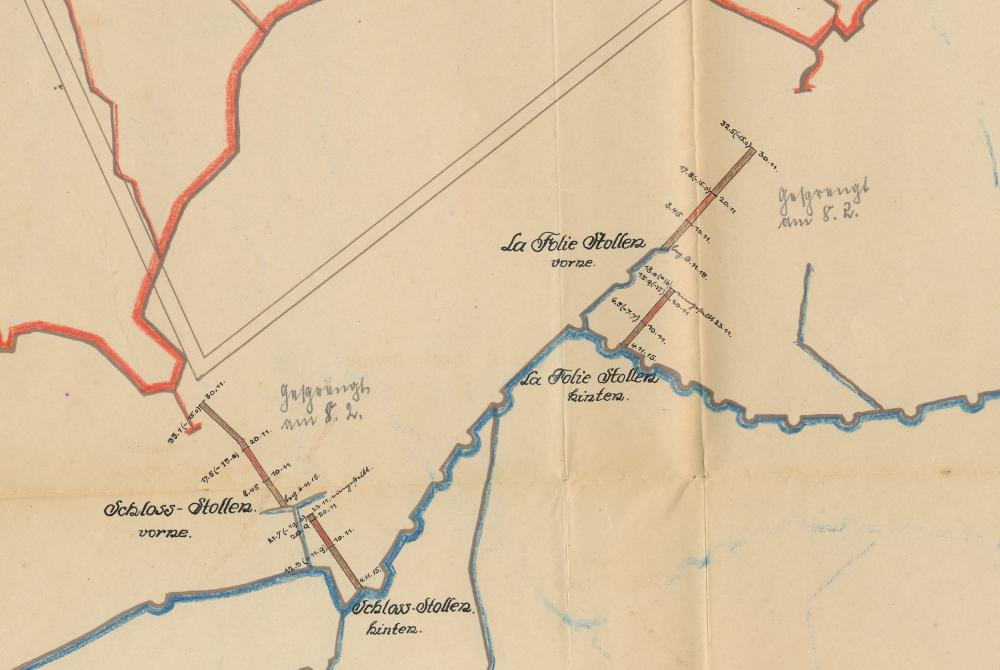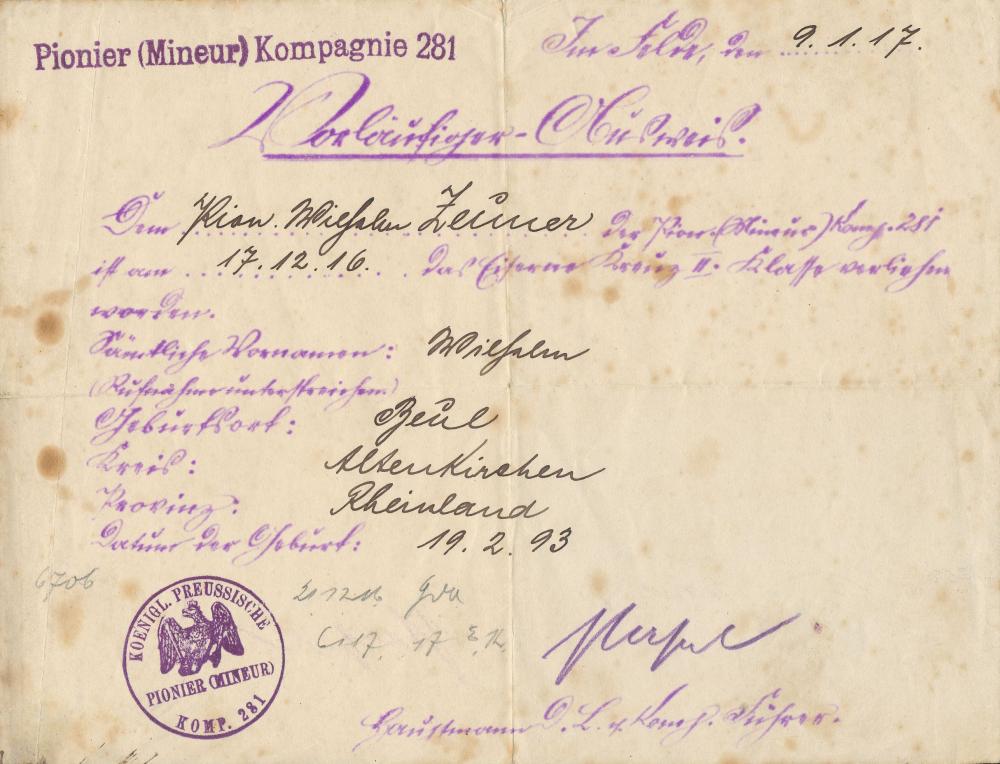-
Posts
29,251 -
Joined
-
Last visited
-
Days Won
84
Content Type
Profiles
Forums
Blogs
Gallery
Events
Store
Everything posted by Chris Boonzaier
-

Death from below
Chris Boonzaier replied to Chris Boonzaier's topic in Germany: All Eras: The Iron Cross
Details of a map belonging to a Pionier Officer serving with the 1st Bavarian Division. It shows the progression of tunnels from the German (Blue) lines to the French (Red). The tunnels were finished on the 30th of November 1915 and detonated on the 8th of February near Neuville St-Vaast as the Germans and French fought for dominance of Vimy Ridge. -
Pionier (Mineur) Kompagnie 281 - Pionier Wilhelm Zeimer The award was made on the 9 January 1917, The document was signed (printed) by Hauptmann d.L. XXX Komp.Führer. I have been unable to pinpoint the unit at the date of the award One of the more frustrating realities related to document research is that many of the smaller units, as interesting as they may be, are very difficult to research. This is often the case with independent Pionier Companys where with much luck they may be mentioned in an account of a famous battle but otherwise do not appear in current or period literature. In some sectors of the Western front the front lines ran too close to each other for artillery to be used effectively. The same was true for certain parts of the front where the protagonists clung to opposite sides of a hill and the enemy on the back slope were not to be reached with artillery. In was in these sectors, most famously on the Vauquois Hill, in some sectors of the Argonne as well as in other sectors such as Les Eparges, Höhe 108 at Berry au Bac, Vimy Ridge and les Hauts de Champagne that the Pioneer Miners were used. For the most part the companies were attached at Armee level. Although they dug tunnels and underground bunkers there main task was offensive mining operations. Starting from the German front lines shafts were dug that led into galleries that went under Nomans land or deep into the side of a hill. Once the gallery was complete it would be packed with explosives, blocked off then detonated. Tons of explosives would destroy the enemy positions above and the surviving infantrymen would then fight to occupy the crater. In some sectors where mining was actively undertaken by both sides there was the constant danger of the enemy breaking into the gallery, or detonating explosives in a parallel gallery and killing the Miners.
-

EK 1914 1914 EK1 mm "FR"+"Fr"
Chris Boonzaier replied to Motorhead's topic in Germany: All Eras: The Iron Cross
Rereading this thread, I stick by this more than ever before... The publication of Wernitz has proved "stuff" that was theory based on long observation... The publication of Wernitz also makes apparent that there are great gaps of knowledge we will probably never find in the archives and will probably only ever have theories for... -

Rarest WW1 EK2 Maker
Chris Boonzaier replied to Chris Boonzaier's topic in Germany: All Eras: The Iron Cross
Gulp.... yes... that probably does cost a pretty penny... different strokes for different folks :-) -

Maybe my favourite cross maker....
Chris Boonzaier replied to Chris Boonzaier's topic in Germany: All Eras: The Iron Cross
Hi, Thats a good start, There was a good discussion going on here... -

Rarest WW1 EK2 Maker
Chris Boonzaier replied to Chris Boonzaier's topic in Germany: All Eras: The Iron Cross
WW2 maker collectors have a dynamic all of their own, I remember when Panzer assault badges, no matter which maker, were around DM70... then variation collectors took off... Forums gave it turbo.... and now the skys the limit for smoe makers... -

Rarest WW1 EK2 Maker
Chris Boonzaier replied to Chris Boonzaier's topic in Germany: All Eras: The Iron Cross
I agree, often rare and desirable dont go gand in hand. I am guessing a period trifold ribbon is worth a bit as well, but I am surprised the L/11 takes the cake... I would have thought LDOs dont reach high prices. I think the WW2 ones are taking off with guys collecting makers, have sen some go for over EUR200... Imperial stays the "ugly Stepson" :-) -
I know Blitz was collecting stats, but what are the most desirable/Rarest/expensive WW1 EK2s out there? I love Godet pieces, but I dont think they are the most expensive?
-

Maybe my favourite cross maker....
Chris Boonzaier replied to Chris Boonzaier's topic in Germany: All Eras: The Iron Cross
P.S. I know they made WW2 crosses. -

Maybe my favourite cross maker....
Chris Boonzaier replied to Chris Boonzaier's topic in Germany: All Eras: The Iron Cross
Is Frank & Reif accepted as a WW1 maker again? Many years ago I called up the firm and had an old gentleman on the line (I cant remember, but I think it was a Herr Reif), he told me Frank & Reif did not make iron Crosses 14-18, and that it was a stamping company as opposed to a jeweller. I think It was also mentioned that back in 14-18 the company had a different name, but dont quote me on that... For me that more or less put a lid on them being WW1 Makers. Of course, Info given by an old employee is not proof, but I have always believed that someone somewhere once went through the list of initials and just matched up known badge maker names. The same list still has the old KO Lemon of Königliche blah blah. Best Chris -

What´s special with this EK I?
Chris Boonzaier replied to The Prussian's topic in Germany: All Eras: The Iron Cross
Looks like a cloth EK1 ! I missed a nice bavarian group with one a few years ago.... -

The REAL Early crosses....
Chris Boonzaier replied to Chris Boonzaier's topic in Germany: All Eras: The Iron Cross
Thanks for the input guys! Is there a trend to the marking or lack of marking on the cast core crosses? i.e. are unmarked crosses more comman on very early pieces? Best Chris -

The REAL Early crosses....
Chris Boonzaier replied to Chris Boonzaier's topic in Germany: All Eras: The Iron Cross
"I refuse to believe that maker´s codes have something to do with (or are helpful in) award/private purchase identification. I would borrow the argument from you, Chris. Some award pieces are unmarked, because in the tide of war there was no time to mark them all. If we are prepared to accept that some vaulted pieces were handed over as awarded only because of wartime lack of sources (and time) then we must accept even quicker, that same thing happened to unmarked crosses." I have a hard time buying that argument, simply because a vaulted cross being used for an award was probably a unit ordering crosses outside of the usual channels... alternately, a maker was surely not under such time pressure that he could not stamp a batch of crosses ? As a matter of interest... what do you think were givenout in 1914? -

The REAL Early crosses....
Chris Boonzaier replied to Chris Boonzaier's topic in Germany: All Eras: The Iron Cross
"And don´t forget, sandcast Godets would have to fit to this theory as well. But they still refuse to." Fact of the matter remains, we still do need a theory for the early crosses.... unless we are to believe they used the codes from the outbreak of the war? :-) I do not even make the claim that I offer a theory, just pose a question :-) -

The REAL Early crosses....
Chris Boonzaier replied to Chris Boonzaier's topic in Germany: All Eras: The Iron Cross
Hi, That would IMHO be too extreme as a comparison, The value of an EK2 compared to a RK is vastly different and an EK2 remains an EK2.... but an EK1 is still an EK1 no matter if stamped with a code or not. -

The REAL Early crosses....
Chris Boonzaier replied to Chris Boonzaier's topic in Germany: All Eras: The Iron Cross
"The best example are two Godets I had - both flat pinbacks with silver frame. One was marked G, second one unmarked. Otherwise totally identical pieces with same hardware, frame condition and stamped core. If the marked one was awarded piece, than the unmarked Godet should be - according to your theory - private purchase." Hi, I have no theory, just questions... technically however, if it were my theory, it would mean your unmarked Godet may have been a early award piece and that they started stamping "G" on at a later date when control stamps were required ? -

The REAL Early crosses....
Chris Boonzaier replied to Chris Boonzaier's topic in Germany: All Eras: The Iron Cross
"As I understood it up to now, the signals of private purchase are - silver content hallmark, vaulting of the cross, using other than pinback hardware. " Here is a wild thought... backed up by ZERO proof... what if the origianal 1914 award EK1s WERE vaulted pieces stamped 800? and the flatbacks with codes became the official ones in, lets say ...1915? The 1914/Pre coded crosses are still for me the missing link... they must exist... but how to recognise them... I keep my mouth closed on the Vaulted issue, but secretly I believe that Vaulted ones WERE also awarded... Why should they not have been? Especially when we see how very many officers wore them... who is to say that some commanders did not choose to give their officers vaulted ones? My wifes Greatgrandfather`s group is complete, including old Yachtclub pins... the only cross is a vaulted one. I have a Photo of a Gefreiter on what looks to be Award Day (from the writing on the back), cross hanging crookedly and a rolled up award document in his hand... the cross is vaulted... I believe it to be the exception to the rule, but I believe the argument that vaulted crosses cannot be award pieces simply does not take into account that an army of millions of men fighting in Western Eurpe, Eastern Front and all the way down to the Gaza Strip sometimes had to improvise to keep things going... even if it included organising some Iron Crosses that did not correspond to the rules... -

The REAL Early crosses....
Chris Boonzaier replied to Chris Boonzaier's topic in Germany: All Eras: The Iron Cross
"2. Technique of stamping and painting cores is quicker than sandcasting/blackening and allows mass production. This is the reason why companies switched to it. I don´t know anything about production price of both technigues, but if you have written order from Kaiser for 100.000+ crosses, you really have no problem with switching techniques, because it is supposed that the price of doing so is incorporated to the price of whole deal." Hi, but if you have a business in a small town making sandcast cores... you may have already reached your production limit and be happy with that... I am sure some big makers did modernise and kick up production, but think that a smaller firm may have continued delivering its 500 cores a month to the assembeler, happy with the money they get and not prepared, willing or able to spend the money to change the tools... -

The REAL Early crosses....
Chris Boonzaier replied to Chris Boonzaier's topic in Germany: All Eras: The Iron Cross
"3. For me it is really new statement, that unmarked crosses are private purchases. As I understood it up to now, the signals of private purchase are - silver content hallmark, vaulting of the cross, using other than pinback hardware. As I know, only about 20% of ww1 Iron crosses are marked. Do you think it means, that 80% are private purchases?" Hi, I dunno, I think most WW1 EK1s are marked, either code, maker or silver stamp. The issue usually comes into play with EK2s and there vaulting and pinback hardware does not help us. I cannot think offhand of a dealer who goes into detail about cores... right or wrong, they usually have "Award pieces" and "private purchase" decided by codes or no codes... -

The REAL Early crosses....
Chris Boonzaier replied to Chris Boonzaier's topic in Germany: All Eras: The Iron Cross
Some good points for discussion :-) "I personally think that if the GODET mark on 1870 crosses and on 1914 private purchased pieces were the same, Chris theory would have some chance. But these MMs doesn´t match. They are the same only in presenting full Godet name, but it is not the same stamp. 1. I think there is no 40 years gap. A type cross, as well as Godet B type cross are known to be produced up to the 1914." Just to revisit this... Fact is Godet DID change stamps... But sofar I am not sure if they did in 1896, 1906 or 1916... I dont think it plays a roll in 1914 crosses. As to the Übergange from making 1870 to 1914... I am guessing they were probably not actively making 1870 crosses anymore. Its a bit like S+L nowdays... they dont make RK to order, they only make lots... so maybe the last 1870 crosses were made in 1900 and there was enough supply that covered needs for a number of years? i.e. 100 crosses made in 1900, but still 40 left on the shelves in 1914? Like I said, just supposing... I find it an interesting topic... -
... to keep a group together? In the past I have gone more than the extra mile, often buying up junk that noone can use, just to keep al the parts together... Now i have a dilema... I have a group with a guys Fieled Grey jacket and 2 of his blue prewar ones.... Would I be a bad guy if I got rid of a blue one? Basically it is double in the group.... I am a bit torn in two over this....
-

The REAL Early crosses....
Chris Boonzaier replied to Chris Boonzaier's topic in Germany: All Eras: The Iron Cross
P.S. ... I know I am offering plenty of questions and few answers... but I think this is a topic that we simply asuume things and have not really questioned them...




